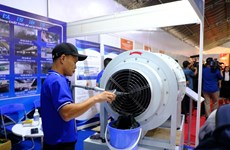Manufacturing back in the red
After adjusting for seasonal factors, including the Tet holidays, the
HSBC Vietnam Manufacturing PMI posted 48.3 in February, down from 50.1
in January.
After adjusting for seasonal factors, including the Tet holidays, the
HSBC Vietnam Manufacturing PMI posted 48.3 in February, down from 50.1
in January.
The PMI therefore posted a reading below the neutral 50 mark – to signal contraction – for the second time in the past three months. Although the rate of deterioration indicated was only modest, it was nonetheless the sharpest since August last year.
Manufacturing production and new orders both fell during February, amid reports of weak client demand.
There were also reports that order levels had fallen as a result of excess inventory holdings at a number of customers. The level of new work declined from both domestic and export markets.
Incoming new export business fell for the tenth successive month, but the rate of reduction eased to a six-month low.
The recent subdued performance of the manufacturing sector filtered through to the labour market, with manufacturing job losses reported for the first time in five months.
Although the rate of reduction was only moderate overall, it was nonetheless the sharpest signal since July 2012. Companies also linked lower staffing requirements to cost control efforts.
Excess capacity persisted in the country’s manufacturing sector, as highlighted by a further decline in backlogs of work during February. The level of outstanding business has now fallen in each of the past 11 months.
February data signaled an increase in average purchasing costs for the second successive month. Companies reported paying higher prices for a range of raw materials, including metals and some food products.
Subsequently, manufacturers adjusted their selling prices higher to reflect part of the increase in costs. Factory gate prices rose for the first time in ten months.
Manufacturers exhibited a cost-cautious approach towards stock-holding and purchasing decisions during February. Lower production requirements led to a slight decrease in input buying volumes, the first reduction for four months.
Meanwhile, inventories of purchases and finished products both fell sharply during the latest survey period, with rates of depletion in both cases the fastest since data collection began in April 2011.
Average vendor performance deteriorated slightly as well, reflecting shortages of certain raw materials at vendors.-VNA
The PMI therefore posted a reading below the neutral 50 mark – to signal contraction – for the second time in the past three months. Although the rate of deterioration indicated was only modest, it was nonetheless the sharpest since August last year.
Manufacturing production and new orders both fell during February, amid reports of weak client demand.
There were also reports that order levels had fallen as a result of excess inventory holdings at a number of customers. The level of new work declined from both domestic and export markets.
Incoming new export business fell for the tenth successive month, but the rate of reduction eased to a six-month low.
The recent subdued performance of the manufacturing sector filtered through to the labour market, with manufacturing job losses reported for the first time in five months.
Although the rate of reduction was only moderate overall, it was nonetheless the sharpest signal since July 2012. Companies also linked lower staffing requirements to cost control efforts.
Excess capacity persisted in the country’s manufacturing sector, as highlighted by a further decline in backlogs of work during February. The level of outstanding business has now fallen in each of the past 11 months.
February data signaled an increase in average purchasing costs for the second successive month. Companies reported paying higher prices for a range of raw materials, including metals and some food products.
Subsequently, manufacturers adjusted their selling prices higher to reflect part of the increase in costs. Factory gate prices rose for the first time in ten months.
Manufacturers exhibited a cost-cautious approach towards stock-holding and purchasing decisions during February. Lower production requirements led to a slight decrease in input buying volumes, the first reduction for four months.
Meanwhile, inventories of purchases and finished products both fell sharply during the latest survey period, with rates of depletion in both cases the fastest since data collection began in April 2011.
Average vendor performance deteriorated slightly as well, reflecting shortages of certain raw materials at vendors.-VNA













